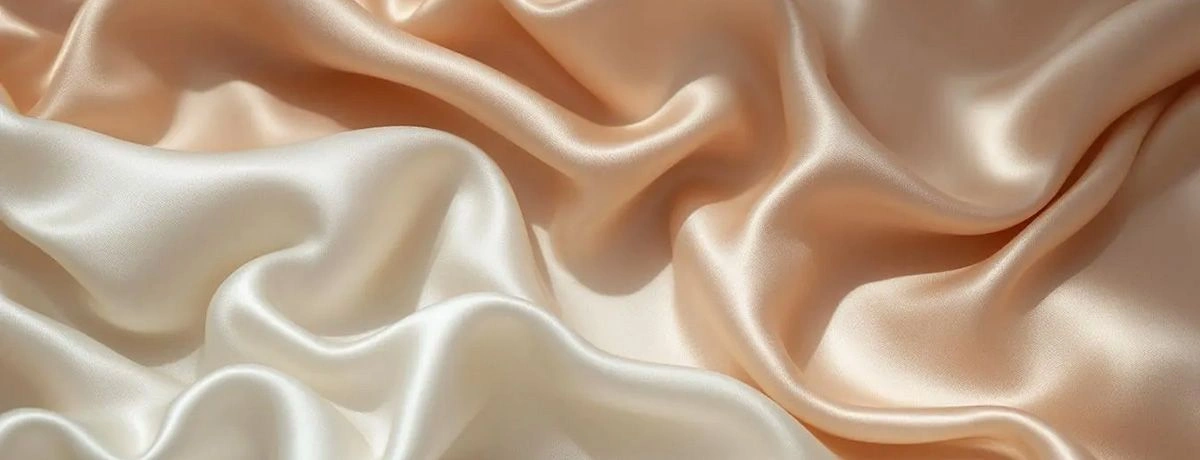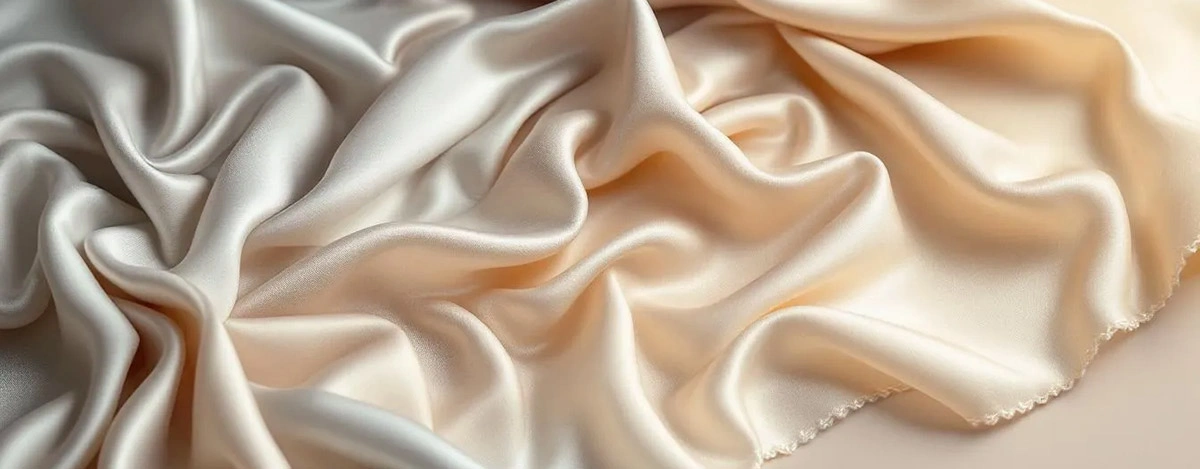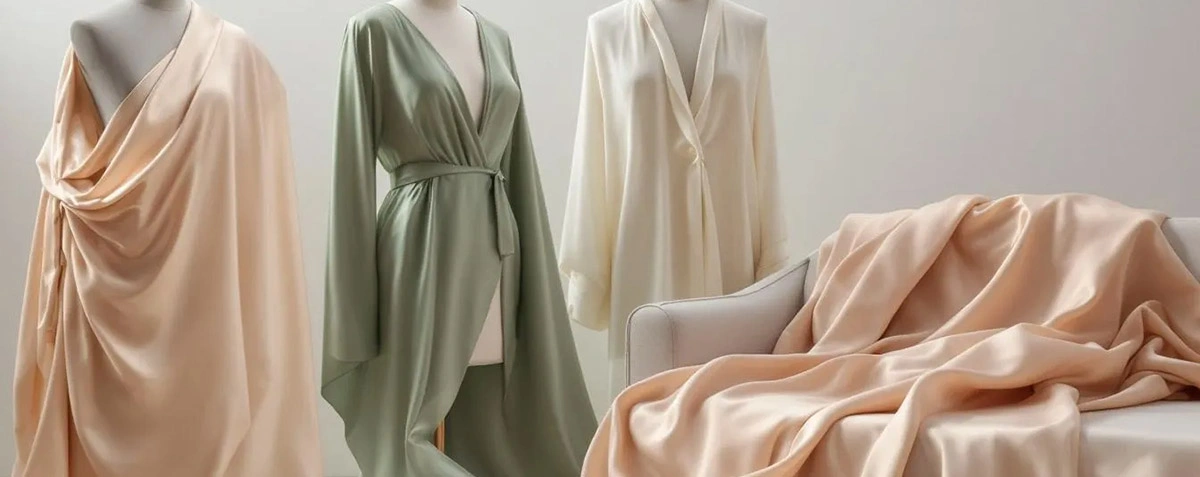Best Silk Fabrics Explained: Types, Uses, and Buying Tips

Silk fabrics are renowned for their luxurious feel and elegant sheen. Treasured throughout history for their comfort and natural beauty, they offer unique benefits. In this article, we’ll explore different types of silk, their uses, and key buying tips.
Key Takeaways
-
Silk fabrics have a rich history and unique properties, such as softness, moisture-wicking ability, and hypoallergenic nature, making them highly valued despite environmental concerns in production.
-
There are various types of silk, including Mulberry, Eri, Tasar, Muga, and Sea silk, each with distinct characteristics and uses ranging from high-quality apparel to luxurious home decor.
-
When purchasing silk, it’s essential to assess quality by considering factors like sheen, thread count, and momme weight, as well as to prefer reputable brands to avoid counterfeit products.
Overview of Silk Fabrics

Silk has been a cornerstone of textile history since around 6500 BC in ancient China, making it one of the oldest known fabrics. Its unique properties include:
-
A shiny and soft texture
-
Moisture-wicking ability
-
Temperature regulation
-
Hypoallergenic nature
These qualities have made silk fabrics highly valued across the globe. The triangular cross-section of silk fibers contributes to the fabric’s smooth texture and its ability to reflect light, creating a lustrous effect that is difficult to replicate with other materials.
The production of silk primarily involves the Bombyx mori silkworm, which requires meticulous care and a significant amount of labor. This process includes the cultivation of mulberry trees to feed the silkworms and the careful harvesting of harvested silkworm cocoons. The silkworm spins a protective cocoon, which is then harvested to extract silk threads.
During production, silk threads are carefully unwound from the cocoon and wound onto a reel. Multiple fine strands are combined to create yarn suitable for weaving into pure silk fabrics.
Silk has played a significant role in global trade and culture. The Silk Road was instrumental in spreading pure silk and other silk fabrics from China to Europe, the Middle East, and Asia, with Chinese merchants dominating the trade routes and expanding the reach of silk worldwide.
The global value of silk remains high due to its luxurious qualities and historical significance. China is the largest producer of silk, benefiting from significant access to advanced automation in production facilities, though this access varies by region and impacts both efficiency and worker conditions.
However, the environmental impact of silk production is considerable, with high energy consumption and water usage being key concerns. Despite these challenges, silk remains an emblem of luxury and refinement.
Fabric Properties
Silk fabric stands out in the textile world for its remarkable combination of softness, durability, and natural luster. The secret lies in the structure of silk fibers, which are made up of two proteins: fibroin, responsible for the fabric’s strength and smoothness, and sericin, which acts as a natural glue. This unique composition gives silk fabric its signature soft, smooth texture and a gentle sheen that catches the light beautifully.
One of the most valued properties of silk fabric is its absorbency. Silk fibers can absorb up to 30% of their weight in moisture without feeling damp, making silk garments exceptionally comfortable to wear in both warm and cool climates. This absorbent quality also helps silk fabric wick moisture away from the skin, keeping the wearer dry and comfortable.
Silk fabric is also known for its impressive durability, especially when cared for properly. Despite its delicate appearance, the long, continuous silk fibers create a fabric that is both strong and resilient. The texture of silk fabric can vary widely depending on the type of silk and the weaving or knitting technique used. For example, charmeuse silk fabric is prized for its ultra-soft, smooth surface, while dupioni silk fabric features a more textured, slightly irregular finish that adds character to garments and accessories.
Whether used for lightweight blouses, luxurious linings, or elegant evening wear, silk fabric’s combination of softness, absorbency, and durability makes it a top choice for high-quality garments and textiles.
Types of Silk Fabrics
Silk comes in various types, each with unique characteristics and uses. Different silks from around the world are known for their intricate patterns, distinctive textures, and deep cultural significance. From the common and widely loved mulberry silk to the rare and luxurious sea silk, the diversity of silk fabrics is astounding.
Some silk fabrics are made from raw silk, which is valued for its natural texture and sometimes stiff feel. Rare silks like sea silk are produced in small quantities, making them especially exclusive. The uniform quality of silk threads can also vary between types, affecting the smoothness and appearance of the final fabric.
This section delves into the specifics of each type and other types, offering insights into their production, qualities, and applications.
Mulberry Silk
Mulberry silk, produced from the Bombyx mori silkworm, is renowned for its exceptional softness and strength. This type of silk is primarily cultivated through sericulture, involving the careful nurturing of silkworms fed on mulberry leaves.
The resulting woven fabric is smooth and absorbent, making it a preferred choice for high-quality garments and silk textiles.
Eri Silk
Eri silk, also known as peace silk, is unique in its production method, which does not harm the silkworms. Instead, the silkworms are allowed to emerge from their cocoons and complete their lifecycle.
This results in a heavier and more durable fabric, ideal for creating long-lasting textiles that are both ethical and beautiful.
Tasar Silk
Tasar silk is produced by wild silkworms, which are typically found in forests. This wild silk is distinguished by its rich texture and natural golden hue, making it a unique and highly valued fabric.
However, the natural color can pose challenges in dyeing, adding to the fabric’s limited exclusivity and charm.
Spider Silk
Spider silk is renowned for its exceptional strength and lightweight nature. However, it is not commonly used in textiles due to the difficulties in producing it in large quantities. Instead, spider silk is primarily utilized in specialized applications where its unique properties, such as high elasticity and tensile strength, are most beneficial.
Muga Silk
Muga silk, exclusive to Assam, India, is celebrated for its natural golden hue and durability. This silk is traditionally associated with royalty and is often used in the creation of luxurious garments that exude elegance and opulence.
Sea Silk
Sea silk is a rare and luxurious fabric derived from the byssus of Mediterranean mussels. Known for its delicate and shimmering appearance, sea silk has been a sought-after material for centuries, though its rarity makes it a prized possession.
Coan Silk
Coan silk, produced from the Pacypasa atus silkworms and silk cocoons, holds historical significance as a textile originating from the island of Kos.
Today, it is primarily used to strengthen other silk fabrics, enhancing their durability and texture.
Uses of Silk Fabrics

Silk has long been associated with luxury and elegance, a symbol of wealth and status throughout history. Its versatility allows it to be used in a wide range of applications, from high fashion to home decor and even industrial uses, including chinese silk. Silk is a preferred material for making suits and lingerie due to its luxurious feel and drape. Compared to cotton, which is also a natural fiber, silk is often chosen for its sheen and softness in high-end garments. Silk fabrics can be woven or knit, allowing for a variety of textures and uses. In industrial applications, silk fibers are used in medical sutures for closing wounds, valued for their biocompatibility.
This section explores the various ways silk enhances our lives, showcasing its timeless appeal and practical benefits.
Apparel
Silk is a popular fabric for creating bridal attire and formal evening dresses due to its elegant drape and sheen. Mulberry silk is particularly favored for its smooth texture, making it a staple in high-quality garments. Additionally, Eri silk offers excellent thermal properties, providing warmth in winter and coolness in summer.
Muga silk, with its striking golden color, is traditionally associated with royalty and used in luxurious garments. Tasar silk is often seen in traditional Indian saris, valued for its unique, lustrous appearance.
The diverse types of silk, including silk satin, charmeuse, and chiffon, cater to various fashion needs, ensuring that silk remains a timeless choice in apparel.
Home Decor
Silk textiles, such as curtains and wall hangings, can significantly enhance the aesthetic appeal of a room. The luxurious texture and sheen of silk add an elegant touch to home interiors, making it a preferred choice for those looking to elevate their decor.
Industrial Applications
Silk fibers are used in various industrial applications due to their biocompatibility and strength. They are often used as suture materials in medical practices, as well as in the production of parachutes and bicycle tires, showcasing the versatility of fiber.
The unique properties of silk make it suitable for advanced medical applications, including tissue engineering.
Fabric Trends and Styles
Silk fabric continues to be a favorite among fashion designers and consumers, thanks to its timeless appeal and adaptability to modern trends. In recent years, there has been a noticeable shift toward sustainable and eco-friendly silk production, with manufacturers exploring organic materials and innovative processes to reduce environmental impact. This trend is especially important for brands and buyers seeking to align with global sustainability goals.
Popular styles of silk fabric remain in high demand, with silk satin leading the way for its luxurious, glossy finish—perfect for evening gowns, blouses, and elegant accessories. Silk chiffon and silk organza are also widely used for their lightweight, airy qualities, making them ideal for layered garments, scarves, and delicate wall hangings. These fabrics are not only favored in the world of fashion but also play a significant role in home decor, where silk curtains and upholstery add a touch of sophistication to any space.
In addition to classic styles, silk fabric is now being combined with new materials and technologies, resulting in innovative blends and finishes that expand its range of applications. From statement garments to decorative home textiles, silk fabric remains at the forefront of both traditional and contemporary design.
MH's Silk Fabric Offerings
MH offers a wide variety of silk and satin-like fabrics, catering to the needs of fashion designers and textile manufacturers worldwide. Known for their high quality and luxurious feel, MH’s silk fabrics are suitable for a range of applications, from bridal wear to home textiles and decorative items. Shipping costs can impact the final price of silk fabrics, especially for international buyers.
MH sources high-quality raw silk for its premium fabrics, ensuring superior texture and durability. In addition to natural silk, MH also provides polyester silk alternatives, and nylon is another synthetic fiber historically used as a substitute for silk, especially during times of silk shortages.
With over 20 years of experience, MH is trusted by garment manufacturers for its consistent quality and reliable supply.
Natural Silk Fabrics
MH provides an array of natural silk fabrics, including:
-
Charmeuse: silk with a glossy finish on one side and a matte look on the other, a luxurious choice for evening wear.
-
Habotai: lightweight silk with a soft drape, often used in blouses and dresses.
-
Organza
-
Crepe de chine.
Different fabrics and their ideal uses include:
-
Organza: known for its crisp and thin texture, ideal for formal garments.
-
Crepe de chine: features a unique crinkled texture, perfect for flowing garments.
-
Chiffon: valued for its lightweight and sheer qualities, making it suitable for delicate designs.
Polyester Silk Alternatives
For those seeking the luxurious feel of silk at a more affordable price, MH offers polyester silk alternatives such as satin. These fabrics mimic the smooth texture of real silk but are more cost-effective and durable, making them popular for budget-conscious buyers.
Custom Designs and OEM Services
MH provides custom prints and dyeing services to create unique silk fabrics that meet specific client requirements. With advanced techniques, MH can produce vibrant and intricate designs on silk textiles, catering to global fashion brands.
They also specialize in crafting silk fabrics with detailed embroidery, adding texture and distinction to their silk industry world site using a needle, with a focus on the lining. For more information, feel free to contact us.
Buying Tips for Silk Fabrics
When purchasing silk fabrics, it’s essential to prioritize reputable brands to avoid counterfeit products. Consider the intended use of the fabric, as different types of silk serve various purposes, from fashion to home decor.
Understanding silk grades and momme weight can also help in selecting the right quality.
Identifying Real Silk
Identify real silk by its high sheen and smooth, soft texture. A reliable method is the ring test: genuine silk glides smoothly through a ring, while synthetic alternatives tend to snag.
Additionally, real silk produces a distinctive crunching sound when scrunched.
Evaluating Quality
Higher thread counts usually indicate finer quality silk, enhancing its softness and durability. The weight of the silk fabric also impacts its quality; heavier fabrics are often considered more luxurious, especially when woven with threads of silk threads.
Assessing these factors can help ensure that you choose a high-quality silk fabric.
Cost Considerations
Silk fabric prices can range from $20 to over $300 per yard, depending on the type and quality. Production costs, which include the type of silk and the complexity of its production, significantly influence the price.
Polyester silk alternatives offer a more budget-friendly option without compromising on the luxurious feel.
Summary
In summary, silk fabrics offer a blend of luxury, versatility, and historical significance. Understanding the different types of silk, their uses, and how to identify and evaluate quality can enhance your appreciation and selection of this exquisite material. Whether for fashion, home decor, or industrial applications, silk continues to be a symbol of elegance and refinement.


